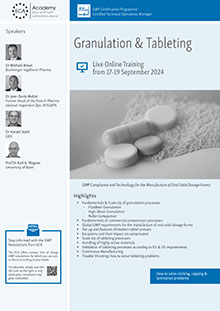Deficiencies in Media Fills and Smoke Studies: Warning Letter

Recommendation
17-19 September 2024
GMP Compliance and Technology for the Manufacture of Oral Solid Dosage Forms
A US-American pharmaceutical manufacturer was inspected by the FDA in February 2020. The serious deficiencies that had been noticed in the media fills and smoke studies were not sufficiently explained or remedied in the manufacturer's response letter, so that a Warning Letter followed.
In November 2019, the US manufacturer had carried out a media fill and received contaminated units. A specific, restricted part of the production line was suspected as a possible source for the microbial contamination. However, the FDA lacks any scientific evidence for this. The FDA also complains that the manufacturer has not initiated any CAPA measures to remove the potential cause. Furthermore, the manufacturer had not performed a risk assessment for other batches that had been produced on the same line. On the contrary, the manufacturer had concluded that there was no influence on the product quality in this case and had therefore cited the passing results of subsequent 2019 media fill runs.
The FDA also criticized the conduct of the Media Fills. The agency had noticed that the interventions simulated in the Media Fill were not representative of the actual interventions in aseptic production.
The FDA also considered the smoke studies in the aseptic production area to be insufficient. The manufacturer had not sufficiently simulated the actual interventions and processes in the smoke studies of its aseptic production area, according to the FDA. On the contrary, the FDA found various deficiencies in the clean room as well as in the production line. According to the FDA, considerable manual intervention takes place with unprotected product and containers/closures. There is no unidirectional air flow, there is even heavy turbulence and the space around the critical area is very limited.
In its response, the manufacturer stated that it had conducted additional smoke studies to prove the unidirectional airflow. This was not sufficient for the FDA, because on the one hand no sufficient visualization of the flow conditions was shown and on the other hand, because the smoke studies had not been performed under dynamic (real) conditions.
For more details please also read the Warning Letter to the US American sterile manufacturer.
Related GMP News
GMP Conferences by Topics
- General Quality Assurance and GMP Compliance Topics
- Hygiene
- General Microbiology Topics
- Regulatory Affairs
- Development
- General Analytics Topics
- Good Distribution Practice
- Sterile Manufacturing
- Computer Validation
- General Qualification/Validation Topics
- General Engineering Topics
- APIs/Excipients
- GMP Basic Training Courses
- Medical Devices and Combination Products
- Packaging and Packaging Material
- Data Integrity
- Qualified Person (QP)
- GMP Auditing
- Documentation
- Cleaning Validation
- General IT Compliance Topics
- Impurities
- OOS / OOE / OOT
- Material Testing
- Validation of Analytical Methods
- Analytical Instrument Qualification
- Stability Testing
- Microbiological Testing
- Technology
- General Manufacturing Topics
- Solid Dosage Forms/Semi-Solid Dosage Forms
- Biotechnology/Blood/ATMP
- Herbal Drug Products/Cannabis/Radiopharmaceuticals
- Others




